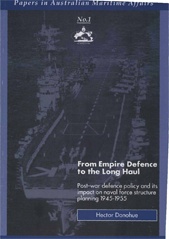Papers in Australian Maritime Affairs: From Empire Defence to the Long Haul: Post-War Defence Policy and Its Impact on Naval Force Structure Planning 1945-1955

PDF : 10.25 MB
Abstract
One of the major tasks facing Australian Defence planners after WWII was the preparation of strategic policies and the development of suitable post-war force structure plans. The Defence budget was restricted after the war, but plans were made to introduce aircraft carriers into the RAN and to provide for a more capable peace time defence force. Force structure plans, approved by the government in 1947, were designed to provide a defence force able to contribute to ANZAM defence plans in the Pacific/Southeast Asia region and also contribute to the UK’s strategy, which in the late 1940s included Australian assistance in the Middle East theatre in the event of war.
The Australian government increased defence spending significantly in 1951 as part of mobilisation planning in preparation for a world war. Despite a flurry of activity, few new force structure initiatives resulted, but, the increased defence spending helped fund the rather ambitious defence program already underway. In 1953, with the likelihood of global war assessed as more remote, but with a deteriorating strategic situation in Asia, Australia finally resolved its strategic dilemma and decided that its defence policy should focus on Australia’s region, that is, Southeast Asia.
A complex defence machinery and a lack of real purpose slowed defence expenditure which, by 1952-53, was capped at about £200m annually. In a landmark paper in 1954, the Defence Minister attempted to impose priorities for force development on the Services to reflect the revised strategic situation, and to put the Defence budget in line with the economic and financial capacity of the Australian economy. This ‘Long Haul’ policy set the scene for the late 1950s which saw the Services face a decline in personnel, equipment and preparedness.


